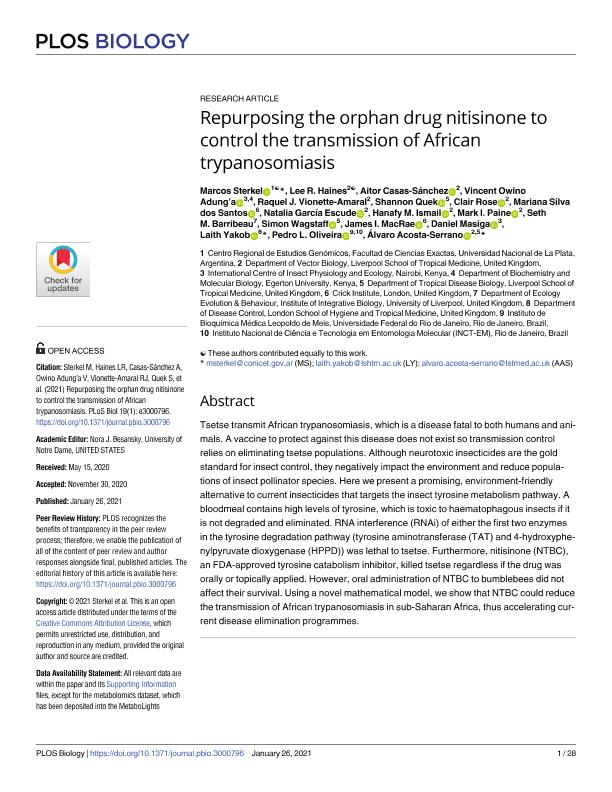Mostrar el registro sencillo del ítem
dc.contributor.author
Sterkel, Marcos

dc.contributor.author
Haines, Lee R.
dc.contributor.author
Casas Sánchez, Aitor
dc.contributor.author
Adung'a, Vincent Owino
dc.contributor.author
Vionette Amaral, Raquel J.
dc.contributor.author
Quek, Shannon
dc.contributor.author
Rose, Clair
dc.contributor.author
dos Santos, Mariana Silva
dc.contributor.author
Escude, Natalia García
dc.contributor.author
Ismail, Hanafy M.
dc.contributor.author
Paine, Mark I.
dc.contributor.author
Barribeau, Seth M.
dc.contributor.author
Wagstaff, Simon
dc.contributor.author
MacRae, James I.
dc.contributor.author
Masiga, Daniel
dc.contributor.author
Yakob, Laith
dc.contributor.author
Oliveira, Pedro L.
dc.contributor.author
Acosta Serrano, Álvaro
dc.date.available
2022-08-11T14:14:00Z
dc.date.issued
2021-01
dc.identifier.citation
Sterkel, Marcos; Haines, Lee R.; Casas Sánchez, Aitor; Adung'a, Vincent Owino; Vionette Amaral, Raquel J.; et al.; Repurposing the orphan drug nitisinone to control the transmission of African trypanosomiasis; Public Library of Science; PLoS Biology; 19; 1; 1-2021; 1-28
dc.identifier.issn
1544-9173
dc.identifier.uri
http://hdl.handle.net/11336/165169
dc.description.abstract
Tsetse transmit African trypanosomiasis, which is a disease fatal to both humans and animals. A vaccine to protect against this disease does not exist so transmission control relies on eliminating tsetse populations. Although neurotoxic insecticides are the gold standard for insect control, they negatively impact the environment and reduce populations of insect pollinator species. Here we present a promising, environment-friendly alternative to current insecticides that targets the insect tyrosine metabolism pathway. A bloodmeal contains high levels of tyrosine, which is toxic to haematophagous insects if it is not degraded and eliminated. RNA interference (RNAi) of either the first two enzymes in the tyrosine degradation pathway (tyrosine aminotransferase (TAT) and 4-hydroxyphe-nylpyruvate dioxygenase (HPPD)) was lethal to tsetse. Furthermore, nitisinone (NTBC), an FDA-approved tyrosine catabolism inhibitor, killed tsetse regardless if the drug was orally or topically applied. However, oral administration of NTBC to bumblebees did not affect their survival. Using a novel mathematical model, we show that NTBC could reduce the transmission of African trypanosomiasis in sub-Saharan Africa, thus accelerating current disease elimination programmes.
dc.description.abstract
Tsetse transmit African trypanosomiasis, which is a disease fatal to both humans and animals. A vaccine to protect against this disease does not exist so transmission control relies on eliminating tsetse populations. Although neurotoxic insecticides are the gold standard for insect control, they negatively impact the environment and reduce populations of insect pollinator species. Here we present a promising, environment-friendly alternative to current insecticides that targets the insect tyrosine metabolism pathway. A bloodmeal contains high levels of tyrosine, which is toxic to haematophagous insects if it is not degraded and eliminated. RNA interference (RNAi) of either the first two enzymes in the tyrosine degradation pathway (tyrosine aminotransferase (TAT) and 4-hydroxyphenylpyruvate dioxygenase (HPPD)) was lethal to tsetse. Furthermore, nitisinone (NTBC), an FDA-approved tyrosine catabolism inhibitor, killed tsetse regardless if the drug was orally or topically applied. However, oral administration of NTBC to bumblebees did not affect their survival. Using a novel mathematical model, we show that NTBC could reduce the transmission of African trypanosomiasis in sub-Saharan Africa, thus accelerating current disease elimination programmes.
dc.format
application/pdf
dc.language.iso
eng
dc.publisher
Public Library of Science

dc.rights
info:eu-repo/semantics/openAccess
dc.rights.uri
https://creativecommons.org/licenses/by-nc-sa/2.5/ar/
dc.subject
Glossina morsitans
dc.subject
tyrosine catabolism
dc.subject
HPPD inibition
dc.subject
African trypanosomasis
dc.subject.classification
Bioquímica y Biología Molecular

dc.subject.classification
Ciencias Biológicas

dc.subject.classification
CIENCIAS NATURALES Y EXACTAS

dc.title
Repurposing the orphan drug nitisinone to control the transmission of African trypanosomiasis
dc.type
info:eu-repo/semantics/article
dc.type
info:ar-repo/semantics/artículo
dc.type
info:eu-repo/semantics/publishedVersion
dc.date.updated
2022-08-03T18:14:33Z
dc.journal.volume
19
dc.journal.number
1
dc.journal.pagination
1-28
dc.journal.pais
Estados Unidos

dc.journal.ciudad
San Francisco
dc.description.fil
Fil: Sterkel, Marcos. Universidad Nacional de La Plata. Centro Regional de Estudios Genómicos; Argentina. Consejo Nacional de Investigaciones Científicas y Técnicas. Centro Científico Tecnológico Conicet - La Plata; Argentina
dc.description.fil
Fil: Haines, Lee R.. Liverpool School of Tropical Medicine; Reino Unido
dc.description.fil
Fil: Casas Sánchez, Aitor. Liverpool School of Tropical Medicine; Reino Unido
dc.description.fil
Fil: Adung'a, Vincent Owino. Egerton University; Kenia. International Centre Of Insect Physiology And Ecology Nairobi; Kenia
dc.description.fil
Fil: Vionette Amaral, Raquel J.. Liverpool School of Tropical Medicine; Reino Unido
dc.description.fil
Fil: Quek, Shannon. Liverpool School of Tropical Medicine; Reino Unido
dc.description.fil
Fil: Rose, Clair. Liverpool School of Tropical Medicine; Reino Unido
dc.description.fil
Fil: dos Santos, Mariana Silva. Crick Institute; Reino Unido
dc.description.fil
Fil: Escude, Natalia García. Liverpool School of Tropical Medicine; Reino Unido
dc.description.fil
Fil: Ismail, Hanafy M.. Liverpool School of Tropical Medicine; Reino Unido
dc.description.fil
Fil: Paine, Mark I.. Liverpool School of Tropical Medicine; Reino Unido
dc.description.fil
Fil: Barribeau, Seth M.. University of Liverpool; Reino Unido
dc.description.fil
Fil: Wagstaff, Simon. Liverpool School of Tropical Medicine; Reino Unido
dc.description.fil
Fil: MacRae, James I.. Crick Institute; Reino Unido
dc.description.fil
Fil: Masiga, Daniel. International Centre of Insect Physiology and Ecology; Kenia
dc.description.fil
Fil: Yakob, Laith. London School of Hygiene and Tropical Medicine; Reino Unido
dc.description.fil
Fil: Oliveira, Pedro L.. Universidade Federal do Rio de Janeiro; Brasil. Instituto Nacional de Ciência e Tecnologia em Entomologia Molecular; Brasil
dc.description.fil
Fil: Acosta Serrano, Álvaro. Liverpool School of Tropical Medicine; Reino Unido
dc.journal.title
PLoS Biology

dc.relation.alternativeid
info:eu-repo/semantics/altIdentifier/doi/http://dx.doi.org/10.1371/journal.pbio.3000796
dc.relation.alternativeid
info:eu-repo/semantics/altIdentifier/url/https://journals.plos.org/plosbiology/article?id=10.1371/journal.pbio.3000796
Archivos asociados
